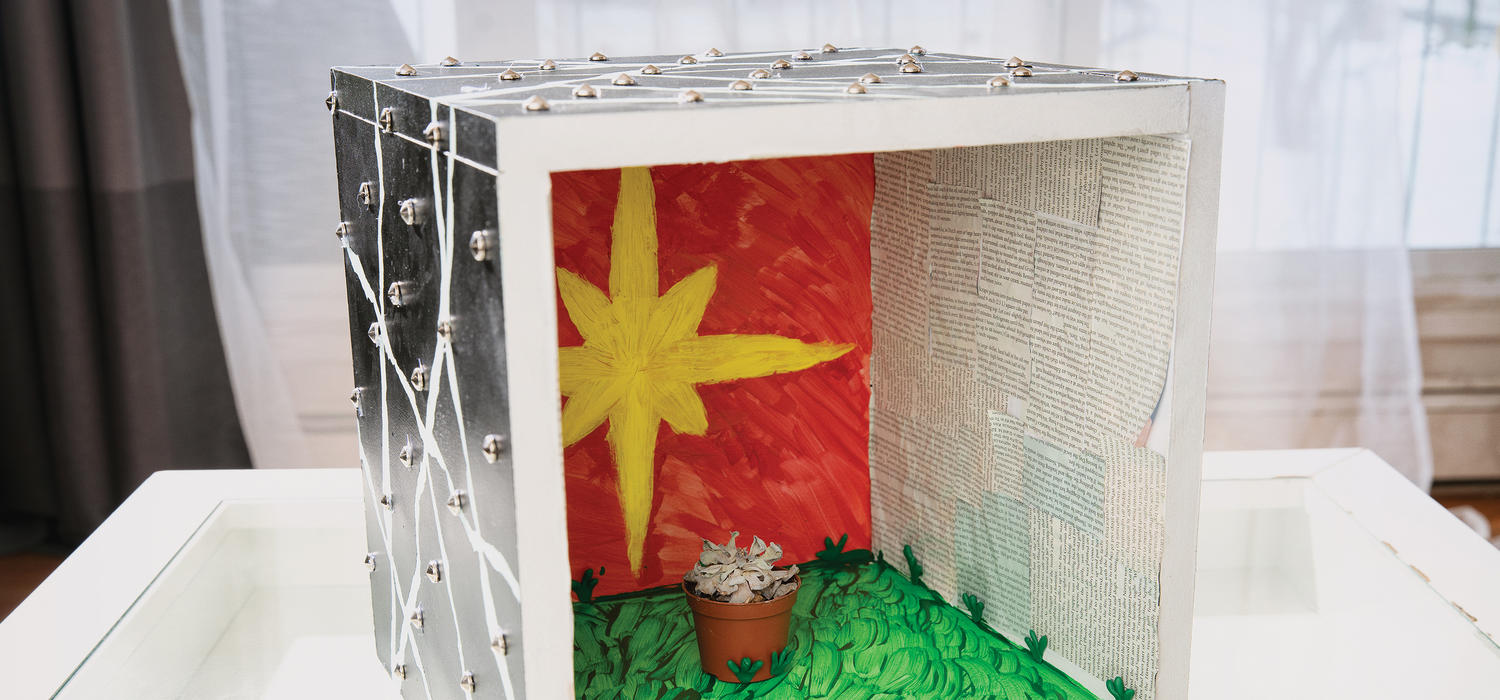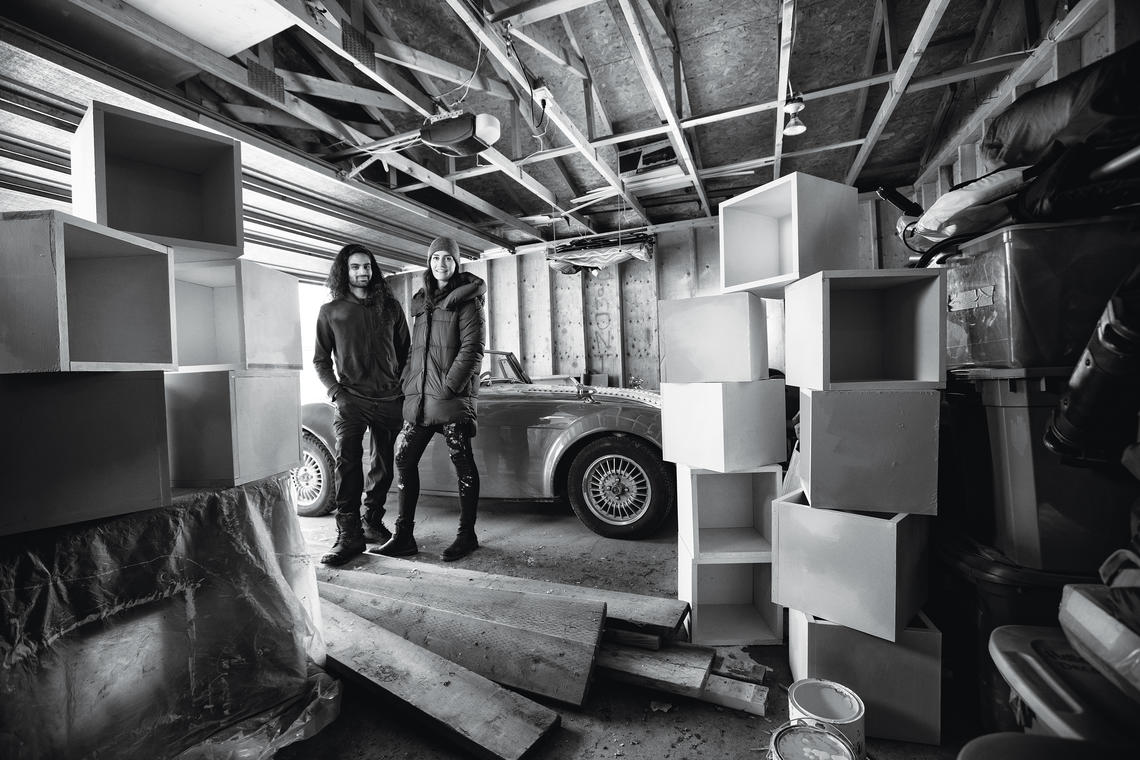The Art of Boxing

We have a lot of boxes in our society.
There are the kind we can see and, for instance, check off on a form or fill with our most precious belongings. It’s the boxes we can’t see, however, that often hold the power to define and restrict our potential.
When it comes to societal notions about what it means to be a “real” man, such boxes can be not only limiting but downright damaging — to the individual compelled toward such a stereotypical image of himself, as well as to those around him.
A new community-led research project from the Faculty of Social Work titled ManBox is exploring our ideas of masculinity by creating actual boxes and asking men to paint and illustrate them to represent the faces they show the world — and, perhaps, who they are inside.
“It’s a heavy box,” says assistant professor and research lead Dr. Liza Lorenzetti, MSW’06, PhD’17. “I think the boxes represent the weight men feel to perform as men in society.”
For social work alumnus Will Tabak, BSW’19, it’s the walls of the box that hold the most significance. “For me, the box represents the unhealthy way that we socialize men and male children,” says Tabak, who works with the Alberta Men’s Network and is co-ordinating the partnership project in the community. “The way we teach them to believe that you can only show the world certain parts of yourself so that people will trust you and see you as a protector — basically, the generalized stereotypes that men tend to live with in society.”
When Tabak created his own box earlier this year, he described the process as transformational. He says he initially tried to rigidly control the process, which in some ways reflected his approach to life and even to his work leading the ManBox project. Tabak’s box helped him realize this and, ultimately, to let go. “I found myself trying to be very open to whatever feeling came into my head and my heart,” he says. “That was what I tried to express at the end of the journey of my project.”
Tabak is hoping to share the therapeutic boxes with men in lower-income or other marginalized communities who don’t typically have access to artistic materials, or who aren’t often asked to take part in reflective, artistic, research-based exercises like this one. He also hopes to provide the experience to men who are reintegrating into society from the justice system. “We think it might help some of these men get back on their feet,” Tabak says.
Like the artists behind them, each ManBox is multifaceted. On the one hand, they’re a tool for social change — a challenge to harmful societal ideas about masculinity. Research shows these stereotypes fuel societal issues like domestic violence, increased substance abuse and higher suicide rates among men. On the other hand, they’re also a tool for reflection built on a theoretical framework of transformational learning.
“The group’s collective project design really resonated with my experience over 25 years of practice in domestic-violence intervention,” says Lorenzetti. “We need to invest — up-front — in well-being, and in healthy relationships and self-care.” People can change, she says, “but they need to engage in personal transformation to do that and — on the ground, in the community — that's where the change is going to happen.”
Working on this box has shown me that I’m a pretty black-and-white person — I see a dichotomy in myself of duty and strength versus emotionality and sensitivity. The night sky represents wonder and ambition; the ocean is spirit and peace; the mountains and valleys are strength and power; the river a symbol of the journey. This project has shown me so much of who I am and allowed me to trust the expression of what I see in my mind’s eye.
-Will Tabak, BSW’19, registered social worker and project co-ordinator of the ManBox Art Project

Will Tabak
Roth & Ramberg
Generations of men have been told it’s a weakness to show vulnerability — that creates a toxic environment. Opening up to my partner and my family, specifically the females in my family, gave me a better perspective on who I am and how I affect the people around me. I’ve felt isolated through COVID, not interacting with my friends in the usual way. Reaching out to friends to say, ‘I’m struggling, wanna go for a dog walk?’ That’s been empowering.
-Ricky Kawa, Co-founder of Sprout Society vegan-meal prep company
Building the boxes for this project was meaningful to me because I want to help make art more accessible and approachable for people. At some point in our lives — maybe especially for men — we’re taught to stop being creative and just have fun with art. I wanted to help celebrate and create opportunity for that.
-Nicole Chalifour, BSW’19, social worker and artist who designed and built the boxes for this community art project

Ricky Kawa and Nicole Chalifour
Roth & Ramberg
I grew up angry and aggressive. I think back to my romantic relationships and where things went wrong. Through therapy and a peer group, I’ve realized how my unpierceable exterior has caused me a lot of distress. Working on this box has deepened my reflection on my struggle with expressing emotions: the metal-studded exterior is prickly and hard to touch and, inside, I layered it with text to show my inner complexities. On the back is a rising sun, to symbolize the dawn of a new day.
-Sebastian Benavides, BA’16, BSW’20, child and youth-care counsellor at Hull Services

Sebastian Benavides
Roth & Ramberg
I think many men fall short in their communication — that hurts them, and it can hurt others. My box symbolizes my sides that people see — a loving father and husband, a musician — and how I feel inside, which is sometimes soft or playful and sometimes foolish or even cracked or breaking down.
The cobwebs show how I can feel stuck or confused and can't always reach the heart there in front of me. The plant extends toward the various facets of me and shows how these complexities can co-exist.
-Arya Boustani, Media technician, with his daughter Parisa

Arya Boustani
Roth & Ramberg
The conceptual artist behind the Man Box Project is Meral Unal. Create your own Man Box and join the dialogue at albertamen.com

